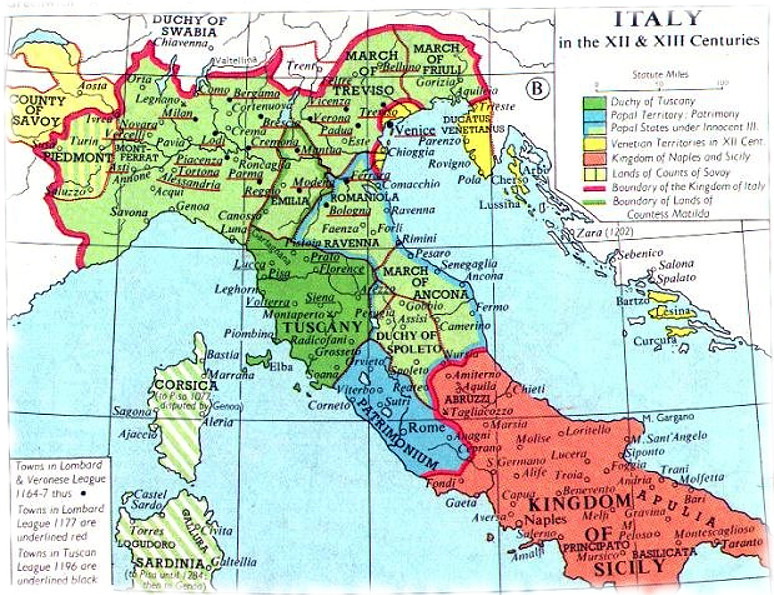Kingdom of Italy
Dark Medieval Italy
By the middle of the 13th century, Italy is a geographical location and nothing more. Kinship comes from cities, which bloom under the pressure of constant immigration from the surrounding countryside, creating a new and complex layered society where both kine and Cainite thrive. As the towns become the centers of commerce, artisans, and traders group into guilds to protect their business from papal and imperial taxing, forming close-knit self-support networks which can be formidable foes – or excellent opportunities for the shrewdest of Cainites. Mimicking the human political structure and taking advantage of its independence, many ancillae have claimed their role as primus inter pares in their city’s area, in open defiance of the larger power structures.
The City-States
Taking advantage of the power struggle between the Pope and the Emperor, some of the largest cities have obtained their independence or act de facto as city-states in their own right, with their own laws, tribunals, and currency. One of the most popular solutions to deal with the litigious families and guilds is to appoint an external podestà, a temporary ruler kept separate from the populace to guarantee their impartiality. As they stand at the apex of their might, some communes are starting to crack under the pressure of internal conflict, but the collapse brought by the Black Death is still to come. With famine and fear will also come the need for absolute rulers, transforming the podestà into signori and destroying the republican nature of the communes.
The Papal States
Depending on who you ask, the Papal States are a province of the Empire or the absolute manifestation of the spiritual power of the Pope in territorial form. The conflict between the Emperor and the Pope has been raging on for centuries, and the two sides are starting to identify as Ghibellines and Guelfs, respectively. The struggle contin- ues all over the northern and central areas of the Italian peninsula, and excommunication is a constant threat. The Emperor, Frederick II, fuels the gridlock by holding the papacy hostage, sending his agents all over central Italy to instigate anti-papal sentiments and support rebellious communes – as long as they will subject to his authority.
Florence and Tuscany
The Republic of Florence experienced a magnificent growth over the past century. Once a minor town in Tus- cany overshadowed by the powerful maritime Republic of Pisa, Florence has risen to the fore thanks to the booming commercial success of its wool industry. Its corporations have become the model for similar institutions all over Italy, as the members of the various Arti control their own trade in order to guarantee specific standards and control their market as cartels. The power struggle between the Arts and the clash between Guelfs and Ghibellines are fueling each other and turning the city into a powderkeg. The next decades will bring constant changes in power structures, leaving room for the creation of a new finan- cial market for the up-and-coming banking and trading families.
While the Guelfs rule the Republic of Lucca, the Ghibelline Republics of Siena and Pisa prepare for war against Florence. Siena sits on the heavily trafficked Via Francigena, becoming the foremost commercial rival to Florence. Meanwhile, Pisa, through its Northern African territories, is a crucial entry point for the advanced Arabic sciences in Europe: its foremost mathematician, Leonardo Fibonacci, grew up in the sophisticated culture of the Almohad Caliphate and brought their number system back to Pisa, but not without some protest and accusation of employing devilish techniques.
Tuscany’s rapid growth has kept it off the radar of most older Cainites. Its internal clashes and contradictions have attracted a panoply of ancillae eager to prove their worth to their sires and make a name for their clan, or simply for themselves. While the port of Pisa is home to Lasombra, Assamites, and even a few Followers of Set, Florence and Siena have a rising Cappadocian presence, through their young and recent Italian bloodline.
